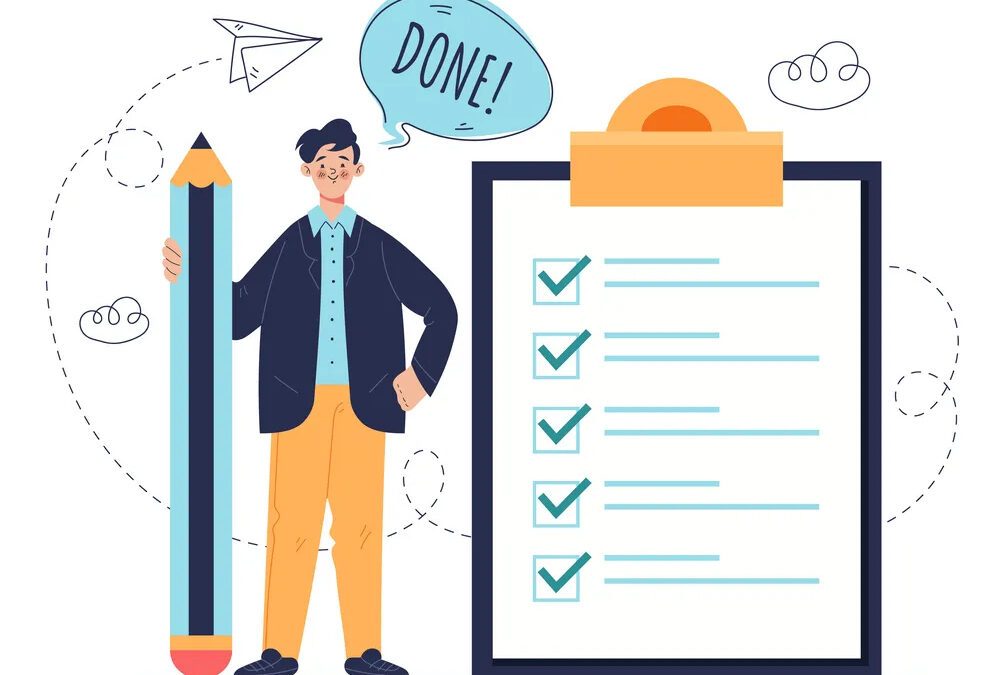
7 Ways AI Can Make Work Life Easier + 80 Prompts to Use
AI has limitations, but it can be a productivity booster when used strategically.
7 Ways AI Can Make Work Life Easier
- Automate repetitive tasks – AI can take over mundane, repetitive tasks like data entry freeing up employees’ time for more meaningful work.
- Improve workflows – AI tools can analyze workflows and processes to identify bottlenecks and areas for optimization for increased efficiency.
- Personalize customer experiences – Chatbots and virtual assistants powered by AI can provide customized service to customers 24/7 to improve customer satisfaction.
- Generate insights from data – AI excels at finding patterns in large datasets. These insights can inform better decision-making and strategy.
- Create content – AI copywriting tools can generate blog posts, social media content, emails, etc. helping your team scale content creation.
- Enhance human capabilities – Rather than replacing humans, AI augments human skills and abilities. For example, AI can help salespeople identify the best prospects.
- Increase accessibility – AI powers assistive technologies that make work more accessible for employees with disabilities.
When thoughtfully implemented, AI technologies can take over repetitive, low-value tasks while empowering employees to focus on more meaningful, human-centric work creating efficiencies while still keeping the human touch.
ChatGPT Advantages and Prompts to Use
- Comparing concepts:
– Please compare and contrast the concepts of [concept 1] and [concept 2].
– What are the key similarities and differences between [concept 1] and [concept 2]?
– Can you explain how [concept 1] and [concept 2] are alike and how they differ in a paragraph?
– Help me understand the relationship between [concept 1] and [concept 2] by outlining their main commonalities and distinctions.
– What distinguishes [concept 1] from [concept 2]? Provide a brief comparison of their defining features.
– Identify 3-5 ways that [concept 1] and [concept 2] are similar and 3-5 ways they are different.
– Create a table comparing [concept 1] and [concept 2] across categories like [category 1], [category 2], [category 3].
– How does [concept 1] contrast with [concept 2] in terms of [specific attribute]? - Researching topics:
– Please provide a high-level overview of current research on [topic] in a few paragraphs.
– Can you summarize the key findings and implications from recent studies on [topic]?
– What are the main themes and conclusions in academic literature about [topic] over the past 5 years?
– Give me a short summary of the state of research on [topic] focusing on the most influential studies and ideas.
– Provide a concise overview of important research on [topic], covering things like main hypotheses, methodologies, results, and limitations of the existing literature.
– In 2-3 paragraphs, synthesize the key insights and open questions from scholarship on [topic].
– What are the critical debates or unresolved questions around [topic] based on a review of current academic research on this subject?
– What are the 3-5 most important papers on [topic] and what are their main ideas and contributions to the field’s understanding of this subject? - Generating ideas:
– Can you provide 5-10 creative and innovative ideas for my project about [topic]?
– What are some outside-the-box ideas I could explore for my [project type] on [topic]?
– Help spur my creativity by suggesting unconventional approaches I could take for [project name].
– Give me a list of thought-provoking and imaginative ideas that would make my [project name] unique and memorable.
– Please brainstorm original ideas for my [project name] that go beyond the obvious – feel free to think wildly!
– Suggest [number] fun, audacious concepts I could incorporate to make my [project name] truly groundbreaking.
– What are some experimental directions I could take my [project name] in to make it innovative and ahead of its time?
– Help get my creative juices flowing by recommending [number] novel ways to approach my [project name].
– Can you play devil’s advocate and suggest some radical ideas to make my [project name] stand out from the crowd? - Drafting emails:
– Please draft a friendly email to [name] asking for advice about [topic].
– Can you write a casual email to [name] introducing myself and discussing [topic]?
– I’d like to email [name] on [topic]. Can you compose a warm, conversational email that briefly explains the situation and poses my question?
– Could you put together a short, upbeat email to [name] about [topic] and let them know I’d appreciate any guidance they can offer?
– Please compose a polite email to [name] on [topic]. Use a positive, collegial tone.
– I want to email [name] to learn more about [topic]. Can you draft a friendly email that briefly sums up my interest and asks them to share their knowledge on the subject?
– Can you write a cheerful and relaxed email to [name] touching on [topic]? - Editing documents:
– Take out all Oxford commas in this document while maintaining the meaning.
– Can you revise this text by removing the Oxford commas throughout while keeping the text clear and readable?
– Please replace all instances of [word 1] in the following document with [word 2].
– Find and replace [word 1] with [word 2] throughout this text without changing the overall meaning.
– Edit the below passage by changing [word 1] to [word 2] wherever it appears. The overall style and voice should remain the same. - Explaining complex topics:
– Please explain the concept of [complex topic] in simple language that a high school student could understand.
– Can you provide a basic overview of [complex topic] using simple words and examples rather than technical jargon?
– I’m having trouble understanding [complex topic]. Can you walk me through the key ideas in plain English for a beginner?
– Using simple analogies and layman’s terms, summarize what [complex topic] is all about.
– Pretend you are explaining [complex topic] to a 12-year-old. Use simple phrases and avoid advanced vocabulary.
– Break down the main elements of [complex topic] into bite-sized pieces that are easy to digest for someone without subject matter expertise.
– Help me understand the fundamentals of [complex topic] by using straightforward language a child could comprehend. - Taking meeting notes:
– Can you summarize the key points from my meeting with [name]?
– I recently had a meeting with [name] about [topic]. Can you briefly outline the key takeaways and next steps we agreed on?
– I met with [name] to talk about [topic]. In 3-4 bullet points, can you highlight the most important conclusions we came to and actions we decided on?
– Please review my notes from my meeting with [name] and provide a concise summary of the essential decisions made, open questions remaining, and next steps.
– I had a meeting with [name] and need help recapping our main agenda items, conclusions reached, and who is responsible for any follow-up tasks. Can you summarize this briefly for me?
– Here are some high level points from my discussion with [name] earlier. Can you distill this down into a short paragraph covering the main takeaways and what we are each going to work on going forward? - Automating tasks:
– How can I automate [task] step-by-step?
– Please provide detailed instructions for setting up automation for [task].
– What is the process for automating [task], breaking down each step clearly from start to finish?
– I want to automate [task] in my workflow. Can you outline the specific steps I would need to take to set this up?
– Could you provide a simple tutorial explaining how to configure automation for [task], including any software or tools needed?
– To streamline [task], can you provide sequential, straightforward instructions on automating it that explain what needs to be done at a basic level?
– Please walk me through how to automate [task] as if you were explaining to someone without any technical knowledge or experience. - Proofreading writing:
– Please proofread the following document for any spelling, grammar, or syntax errors.
– Can you review this report for typos, grammatical mistakes, and overall clarity? Let me know if you have any suggested improvements.
– I need this [document/email/report/etc] checked for spelling and grammar errors. Can you read through it carefully and correct any issues you find?
– Please thoroughly proofread the below text and fix any spelling, punctuation, or grammatical errors you come across to make it read clearly.
– Could you edit the following passage to ensure the spelling, grammar, and sentence structure is correct? Flag any problematic areas.
– I want this to be error-free. Can you proofread this [document/transcript/article] and make sure the spelling, grammar, and punctuation are right?
– Please polish up this [document] by correcting any typographical, spelling, grammar, or syntax errors to get it presentation-ready. Focus on precision. - Summarizing documents:
– Please summarize the key takeaways from this long article in 2-3 sentences.
– Can you summarize this [document] in 3 short bullet points?
– Please provide a concise 150-word summary of the key points in this [document/article].
– I don’t have time to read this entire 10-page article. Can you provide a short summary highlighting the most important information and takeaways?
– What are the critical themes and implications in this dense, lengthy article? Please concisely summarize them for me.
– Please extract and summarize the core findings and arguments made in this very long journal article in no more than 150 words.
– I need help identifying the most significant points in this very detailed, extensive report. Can you summarize the main takeaways in a few bullet points?
– Could you read through this full research paper and highlight the fundamental concepts, conclusions, and insights in a short synopsis?
– Please distill this lengthy analysis into a concise summary covering the overall purpose, methods, key results, and implications in 2-3 paragraphs. - Analyzing reviews:
– Please review these customer comments and identify the overall sentiment as positive, negative or neutral.
– Based on these user reviews of our [product/service], would you say the feedback is generally positive, negative, or mixed? Please explain your analysis.
– Can you read through these survey responses and summarize whether customers are satisfied or dissatisfied with their experience? Include relevant examples.
– What is the overall sentiment from customers in these social media posts about our brand? Are they praising, complaining or providing suggestions? Please categorize.
– I want to understand how customers feel about this new feature based on their feedback. Can you analyze these quotes and tell me if reactions are positive or negative overall?
– Please go through these app reviews and tell me if the common themes suggest users are happy or unhappy with our recent updates. Justify your conclusions with evidence.
– “Could you review our latest customer service transcripts and identify any common pain points or frustrations? I want to improve the areas generating the most negative sentiment.
For complex marketing tasks like strategic planning, creative campaigns, analytics, and SEO, AI has limits. Since everyone is using the same tools and getting similar suggestions, the results won’t help you stand out from your competition. For customized strategies that help you beat your competitors, it’s best to partner with an expert marketing agency. Their tailored approach focuses on your specific business goals.
AI is best used for routine drafting and editing tasks. But humans provide the high-value strategies, creative, and marketing insights that can boost your business.
Need assistance using AI to enhance your marketing initiatives? Schedule a call or email Lori Berson at lberson@BersonDeanStevens.com.
BersonDeanStevens has been a recognized brand strategy and marketing leader for over 25 years. We work in partnership with you to differentiate your brand and achieve your business goals. Client list.
